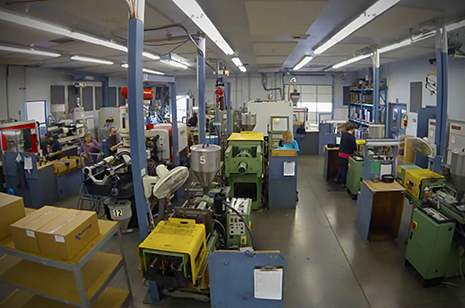- BY nwmcadmin
- POSTED IN American Manufacturing, Plastic Injection Molding, Plastic Injection Molds
- WITH 1 COMMENTS
- PERMALINK
- STANDARD POST TYPE

You’re not alone. At any given moment, somewhere in the world, someone struggles with the same plastic injection molding challenge: There is a part on a plastic injection mold that you need to modify, but you don’t want to buy a new one. Our advice to anyone facing this situation is don’t reinvent the wheel—especially when it comes to sprockets and mini installers. At Rex Plastics, we help countless customers “modify the wheel,” saving them valuable time and money.
Recently, we worked with two customers who both had existing plastic molds that worked, but they needed to be tweaked. Building a new plastic mold was out of the question. The costs were too high. Each customer needed a custom plastic mold. And that’s where we stepped in. Rex Plastics was able to modify each customer’s existing part, resulting in hundreds of dollars of savings.
What Does It Take to Modify an Injection Mold?
Many customers wonder if it’s even possible to modify an existing injection mold instead of creating a new one from scratch. The good news? In many cases, it is—and it’s one of the most cost-effective ways to adjust production without starting over.
If you’re looking to modify an injection molded part due to a design update, function change, or cost-cutting strategy, our team can evaluate your current tooling to see what’s possible. Depending on the mold’s design, we may be able to alter a cavity, add a shut-off, or adapt features using advanced machining techniques.
Not every mold can be modified, but it’s worth asking. Sometimes, minor adjustments can lead to major savings—just like in the sprocket and mini installer cases below.
Cost-Saving Case Study #1: Sprocket
Challenge
Our customer needed a part similar to one that we had produced for them but wanted to avoid the cost of a separate mold.
Solution
We reviewed the customer’s current mold and discovered that there was enough room to add the new part to the existing mold. We added the new part to the existing mold and installed a shut-off so they could order either part.
Benefit
Our customer saved approximately 40% of what it would cost to manufacture a new mold and is now able to produce both parts with the same tool.
Cost-Saving Case Study #2: Mini Installer
Challenge
Our customer had a product that required a hand-loaded core in their mold to produce internal threads and needed a much smaller part with the same threads.
Solution
We reviewed the customer’s current part and determined that we could use the same core for the new part. A new mold was created using the same core.
Benefit
Our customer was able to avoid the cost of reproducing the core component and saved hundreds of dollars.
When Do You Need to Make a New Mold?
While modifying a mold can save time and money, it’s not always the right solution. If your product requires significant changes in geometry, wall thickness, or material compatibility, building a new mold may be the smarter long-term investment. In some cases, it is possible to replace specific components, such as side-actions, without altering the entire mold or parting line.
At Rex Plastics, we’ll walk you through whether you can modify an injection molded part or whether you’ll need to make a new mold entirely. Either way, we help you understand the trade-offs in cost, lead time, and performance.
Our production capabilities allow us to create precise, custom tools using hardened steel or aluminum, depending on your production volume and part complexity. If a new mold is needed, we’ll ensure it’s built to last.
Can You Modify a Plastic Part Without a New Mold?
Sometimes, customers ask if they can just tweak the part itself without touching the mold. Unfortunately, injection molding doesn’t work that way. Any change to the final plastic part usually requires a corresponding change to the mold tool. But the good news is that modifying an existing injection mold is often faster and less expensive than you think—especially if you’re only adjusting features like hole placement, thread design, or logo embossing.
Get Expert Advice on Mold Modifications
At Rex Plastics, we help our customers modify a wide range of plastic molded parts. If you’re worried you need to reinvent the wheel, contact us to see how we can help you modify your existing plastic molded part. We bet our team can help you save money.
Why Rex Plastics
Beyond modifications, we’re proud to offer many types of services, including plastic injection molding services, done by a local team of experienced and dedicated operators. We are a full-service custom plastic injection molder and mold maker. We can bring your idea, part, or product to life from conception to completion in the following areas:
- Custom services for OEMs
- Services for startups
- Plastic injection molding
- Plastic injection mold making
- Plastic product design
- 3-D printing services
Request a quote today.
Frequently Asked Questions
| Question | Answer |
Can modifications to an existing mold affect the lifespan or maintenance needs of the tool? |
Yes, modifying an existing mold can sometimes impact its longevity or maintenance schedule, depending on the extent and nature of the changes. For example, adding features or altering cavities may introduce new wear points or stress areas. At Rex Plastics, we always evaluate the potential effects on mold durability and advise clients on any adjustments to maintenance routines to ensure continued optimal performance. |
How do you ensure that modified parts remain consistent in quality with the original design? |
We use advanced inspection and quality control techniques, such as coordinate measuring machines (CMM) and in-process monitoring, to verify that modified parts meet all specifications. |
What is the typical turnaround time for modifying an existing injection mold versus building a new one? |
While every project is unique, modifying an existing mold generally takes less time than building a new tool. Simple modifications might be completed within a few days to a couple of weeks, depending on complexity and our current workload. New molds, by contrast, can take several weeks to months. We always provide a detailed timeline after assessing your specific requirements. |
Are there limitations on the types of plastics that can be used after a mold has been modified? |
Material compatibility is an important consideration. Some modifications may require reviewing the mold’s suitability for different resins, especially if you’re considering a switch to a new plastic type. At Rex Plastics, we assess factors like melt temperature, flow characteristics, and shrinkage to ensure the modified mold will perform reliably with your chosen material. |
Can you assist with design changes if I only have a physical sample and no CAD files? |
Absolutely! Our team of experts will work closely with you to help develop the necessary design files and bring your idea to life. We can guide you through the design and development process. Just reach out and we’ll help you find the best path forward. |



The blog “Modify a Plastic Molded Part: A Case Study” offers an insightful examination of the process involved in modifying an existing molded part. The author clearly outlines the challenges faced and the solutions implemented, providing practical examples that illustrate the importance of design flexibility and innovation in manufacturing. This case study serves as a valuable resource for professionals looking to improve product performance and efficiency. Thank you for sharing this informative analysis, and I hope to see more case studies that highlight best practices in plastic molding!